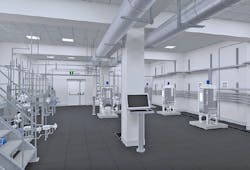Product Focus: Machine-guided manufacturing
Machine learning is no longer a fringe concept. From artificial intelligence (AI) to virtual reality (VR) tools, machine learning solutions have invaded processes throughout pharma facilities.
And with new therapies becoming more complex to produce, the need to utilize high-powered tech to aid operations is growing as well.
“Pharmaceutical manufacturers are under increasing pressure to deliver more productivity,” says John Vitalie, chief executive officer of Bigfinite. “With almost half of new drugs approved being single-batch, personalized medicines, the average tenure of market-leading drugs has halved, and along with new biotech processes, this all contributes to a rapidly changing manufacturing landscape.”
Here is a look at some of the AI- and VR-powered solutions that are transforming every phase of pharma processing from early drug discovery to manufacturing on the pharma plant floor.
A new way of researching
According to Shohei Imamura, strategic project manager, Olympus Corporation of the Americas, AI technology is enabling groundbreaking analyses of cells that, until recently, seemed impossible to achieve.
“Deep learning enables many things that are difficult to realize in traditional image analysis, such as the prediction of the position of the nucleus in label-free cells,” Imamura says. “With deep learning technology, this prediction becomes simple to do.”
To utilize AI in cell imaging, Olympus launched its scanR high-content screening (HCS) station that combines self-learning microscopy — reducing photobleaching and improving speed, accuracy and measurement sensitivity — with high-throughput deep-learning analysis technology based on a dedicated convolutional neural network architecture. The company says that the scanR system excels in drug discovery applications, showing the biochemical effects of compounds on the cellular level and drug-induced changes at gene expression levels.
“Additionally, deep learning makes it easy to predict fluorescence signal from extremely low exposed images,” Imamura says. “These advantages help contribute to improved throughput, reduced photo-damage, and lower costs.”
Transforming training
AI and VR tools are by no means a replacement for employees. But, of course, they can help make operators better at their work, especially when they’re in training.
“The pharmaceutical and life sciences industry is undergoing immense change, and the amount of information employees are expected to retain is ever increasing,” says Graham Provost, global director, AVEVA Unified Learning. “The mounting information means people can’t always remember the critical things right in the moment of need. This can be especially damaging to a manufacturing division, as it can cause safety and compliance issues as well as lower equipment availability.”
To help improve worker performance, AVEVA partnered with Axonify, a B2B SaaS company, to offer adaptive microlearning powered by AI as part of its Unified Learning solution. According to the companies, the program includes a single, integrated platform encompassing simulation for training with extended reality capabilities; tools for designing learning and development programs; flexible deployment enabling customers to choose cloud, hybrid, or on-premises implementation; and AI to fill knowledge gaps with personalized training.
Overall, the companies say that the training program helps drive measurable outcomes for organizational competency needs.
Emerson has also released a VR-based learning solution called Mimic Field 3D that provides an immersive environment for planning, training and operations support.
“A key element of the pharma 4.0 digital transformation is to ensure organizational readiness for newly deployed products and advanced applications,” explains Bob Lenich, director for global life sciences, Emerson. “If operators don’t effectively use new work practices and technologies, the facility won’t achieve its performance goals.”
Emerson says that Mimic Field 3D provides a realistic way to develop operations skills without the need for actual unit operations exposure or the plant to be built. Specifically for the life sciences industry, Mimic Field 3D enables critical training and maintenance experience in areas such as gowning, sample taking, facility awareness, asset tracking, and emergency facility training in a safe environment without affecting production.
Ultimately, Emerson says that “Mimic Field 3D empowers new workers to acquire knowledge and experience at a faster pace as they learn from each immersive experience, enhancing safety and overall operational performance.”
Understanding data
Principal Component Analysis (PCA) is a commonly used way of navigating large data sets and seeing the relationships between variables. In manufacturing, it can help companies visualize trends in operations. But much of this process has typically been achieved manually — until now.
Recently Bigfinite released its GxP AI-powered platform, which Vitalie says was designed to help manufacturers navigate these new challenges.
“The Bigfinite GxP AI powered cloud platform…and the new PCA application is the first real-time, cloud-based PCA available on the market,” Vitalie says.
According to the Bigfinite, its PCA application is a ready-to-use component of its GxP AI-enabled cloud platform, and provides root cause analysis and predictive deviations capabilities for pharma and biotech manufacturing. The company says that the new PCA application uses advanced, multivariate statistics combined with AI to help manufacturers better analyze and control their processes.
The Bigfinite GxP PCA application leverages AI to transform complex relationships in data sets.
“Combined with AI, pharma manufacturers have unprecedented access to transform complex relationships in data sets to versions with fewer dimensions to easily identify variances in data,” Vitalie says. “Ultimately our PCA application can enable more accurate data-driven decision-making, which will result in higher productivity.”
Top image: Emerson’s Mimic Field 3D provides a realistic way to develop operations skills without the need for actual unit operations exposure.

